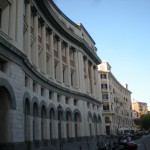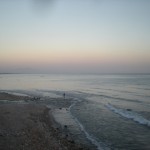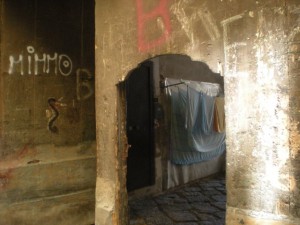Mistaken
Our last, major excursion in the south was to the isle of Capri. Accent on the first, people. CA-pri. There you go.
Honestly, I’m not a huge fan. Again, I’m sure it’s much better in the off season. (Like everything else.) The day we went, it was a demonstration of just how commercial and overrun a beautiful place can become when it’s known as a hangout for the rich and famous.
There were some redeeming elements to the trip. The ride out, while long, was beautiful. We skipped along the coast, stopping at several Amalfi Coast towns. We took in the caves, lighthouses and cathedrals again.
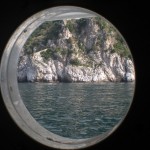
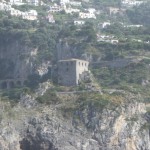
They were, after all, beautiful.
And we had a terribly entertaining deckhand.
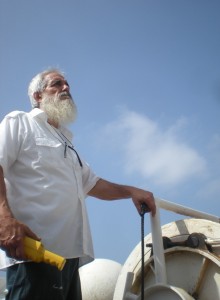
The approach to the island was fairly dramatic.
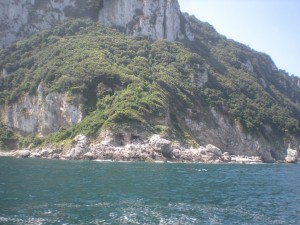
I find that cliffs make everything seem glamorous.
Capri is most famous for its “Blue Grotto,†a cave that emits a beautiful, blue light due to the light being reflected through the water and off of the limestone. We didn’t make it there.  Overhearing that the rough seas and mobs of tourists had made the entrance to the cave “hell†from a private guide who was talking on his cell phone to one of the boatmen at the cave, we decided that we’d forgo the trip out.
Instead, we opted to head up the side of the island via funicular. In fact, we decided to follow the guide and his two American clients. They seemed to have a plan that included a walk around the tip of the island, and some food. We like food. And we like local recommendations for food. So, we fell into stalking mode. I’ve been wandering around alone for long enough to be pretty good at following paid guides without actually paying. Yeah, it’s a skill I don’t usually brag about.
Knowing that we could catch them at the top of the hill, we bought our tickets and climbed aboard the funicular. Now, those of you who have watched Amazing Race will know what a funicular is. For everyone else, it’s a kind of wonky boxcar that takes people up the side of a hill/mountain. It’s at an angle. All of it. In order to keep people standing up straight, the car is strangely angled up , creating a Wonka-vator effect.
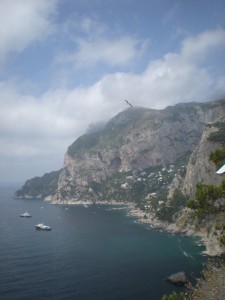
But by that time we were starving, and the Ant had to pee. A lot. After some coaxing, I approached our hijacked guide.
“Excuse me. It seems like you know this place pretty well.â€Â I’d had to interrupt after waiting a few minutes for a break.
“A bit.â€Â He smiled. His clients did not.
“Is there anywhere you’d recommend to eat?â€Â We couldn’t wait any longer to follow him into a restaurant.
“Hmm.â€Â He proceeded to take several minutes to tell me that the place he would usually recommend was closed on Wednesdays, and that there were plenty of places back down by the funicular. About 15 minutes hike back down the mountain.
“Thank you.â€Â I tried to act grateful and not irrationally frustrated. We’d followed him, on my suggestion, to a dead end at the top of a mountain. Fantastic.
If we had to walk back and start over, at least the view was pretty.
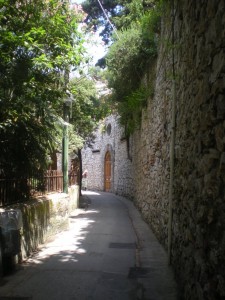
This part of the island seemed far less frequented than the rest. Quiet and unassuming, villas hid behind hedges and locals walked the streets.
We found our way back to the main square and headed into the Medieval part of town. I think we stopped at the first restaurant we found, grateful for a place to sit.
The white walls were hung with black and white pictures. A single-browed youth stood in a black apron, serving smiling celebrities. A young man with the same brow leaned in, smiling next to glamorous women. A man, with a shock of black hair embraced the customers as they posed together.
I looked up and noticed a man, with graying hair and eyebrows coming together in the middle standing against the wall next to the kitchen door. He surveyed the room. Not a celebrity in sight. Just a table of Japanese women and a couple of Americans, too exhausted to talk.
We ordered lunch, a couple of pasta dishes that were good, a cheese plate and desserts to match.

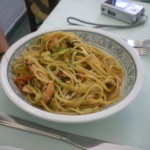
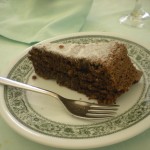
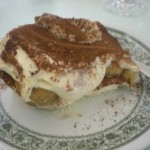
Then we headed back into the insanity to do a bit of shopping and snap some pictures with the rest of the crowd.
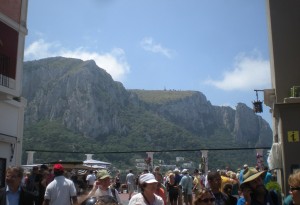
There were some beautiful parts of Capri. If I could squint my eyes, and vanish the hoardes, I could see how pretty it was. What had brought generations of royalty here.
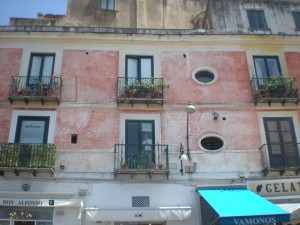
But it wasn’t sustainable.
We walked into a shop to buy a gift for my Grandfather. The Greek flag watch had caught our eye as we walked by. In Italian, we worked through the item, the price, and whether we could easily change the battery. As we went to leave, the woman behind the counter stopped me.
“Italiana?â€Â Seriously? She wanted to know if I was Italian? After a conversation in my broken language?
“No. Americana.â€
“Pero, parla l’Italiana.â€
“No, un poco.â€Â I seriously didn’t speak Italian. Only the littlest.
“Pronuncia bene.â€
“Grazie!†I beamed. Nobody had ever told me that I pronounced the language well. For someone who nearly worships words, this was a high compliment.
We smiled at each other and bid goodbye.
The next few hours were marked by a ride down the funicular, where we listened to a woman screaming at the attendants in an accented English and Italian mixture. I mused at the tiles in the station, thinking of her as the crazed barbarian, and us as the serene mountain goat.
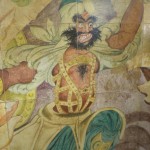
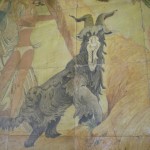
Once at the bottom, we purchased our tickets for the return boat ride, bought a couple of granite (slurpies) and camped on a little strip of beach to watch the piercingly clear water holding up the small boats that bobbed on its surface.
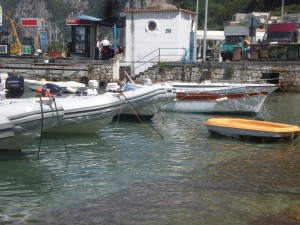
I even found some time to post a few items to the interwebs.
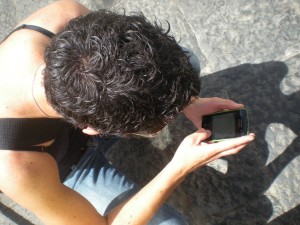
We were so ready to leave the little island that we boarded our boat 40 minutes early and watched, horrified, as ships from Naples unloaded still more people onto the protesting docks.
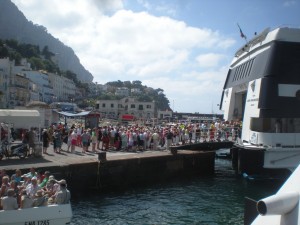
The ride back, however, was a delight. First, we were mistaken for – wait for it – Canadians! That’s right! Some lovely people behind us tapped us on the shoulder and asked if we were from the Great White North! Then they told us that Idaho was close enough. I like Canadians.
We spent the next two hours chatting with them about everything. They were lovely people who were just ending their 3 week trip to the country.
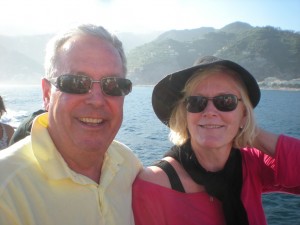
We took each other’s pictures and exchanged contact information. It is always a delight to meet new people, and Roy and MaryLou were extra delightful. After about an hour, Roy asked me a question about our President.
“I can’t tell your politics,†he said deadpan.
I laughed hard, and slapped him on the shoulder. I’m still not sure if he was kidding. I love Canadians. Have I mentioned that?
The second thing that made the ride back extra lovely was the light. It was absolutely stunning. Almost as if it was coming from under the water, shining up.
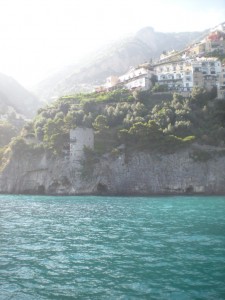
It made the lighthouses and jewel-like cities sparkle more than usual, and made the boats look like they were floating in air. Or Jell-O.
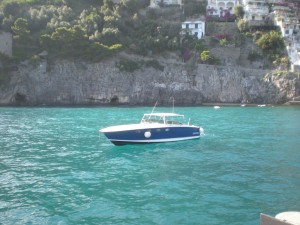
Even the docks were alive, sparkling like diamonds
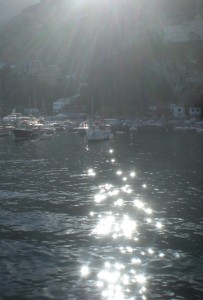
The docks.
Here’s the thing, we didn’t take off from the docs of Salerno.
Hmmm. As we pulled into the slip we realized our error. We were coming into a different port in Salerno. About 2K from where we should be. If there’d been an option, we would have taken it. But there wasn’t, so we walked. Through the streets, through parks, along the water.
And we reminded each other that, even though we were tired, and burned out from a long, exhausting day, life was beautiful. We were in Italy. And we’d just been mistaken for both Italians and Canadians.
Bella, eh?
July 2, 2010 1 Comment
Angels and pizzas
“Napoli e bella.â€Â We’d heard it pretty much every time we mentioned to anyone that we’d be in the south of Italy. At least from the folks in Italy. One of my good friends had spent time there, and she was also a big fan, but other than that, I’d heard that Naples was dirty, dangerous, and really nothing great. Still, “Napoli e bella,†echoed in our ears.
“I think we should do Naples.â€Â The Ant and I were planning our last week in the south. “I mean, our family is from there.â€
“Yeah,†she agreed. “If grandpa was here, he could tell us all about it.â€
On our trip to the north, we’d been hesitant to tell people where our family was from. Naples has a reputation, and Campo Basso, where my great grandmother was from, doesn’t seem to be much better. The usual response we would get was a, “mmmmm†and a changed subject. But here, far south of Naples, it seemed to be the crown jewel, a beautiful metropolis.
Our day started as it usually did, with a cappu, a pastry, and a ride on a bus.
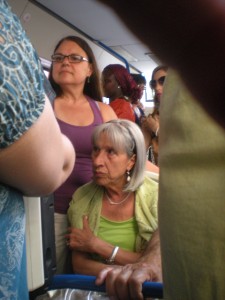
A pretty darn crowded bus.
Then a ride on a train. The a ride on a subway car. One that went from empty to packed in approximately 20 seconds.
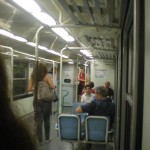
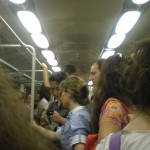
If Rome is the best of everything, Naples is the most of everything. It’s intense, like bone marrow cooked down to its absolute essence, earthy, pushy.
We were only spending one day in Naples, so we wanted to hit the highlights. Museum and pizza were high on the list. When we emerged from the subway, we were hot and disoriented. We’d watched a grandmother struggle aboard the car and, practically collapse into a seat that was quickly vacated by a hoard of giggling high-school aged girls. She fanned herself with a collapsible fan she pulled from her purse and muttered rapidly about the heat. The girls sat on each other’s laps to make room for her and rummaged in bags to find water to offer her.
Now, above ground, we were rummaging for our own water bottles, and I was looking for the “big, red building†that Rick Steves had described as marking the National Archeological museum. Now, Rick has done me very well in the north, but his apparent ignorance of/loathing of the south was starting to annoy me. (Yes, Frank you were right.)
As I looked up the street, up a hill, I saw at least 3 big, red buildings.
“Um, maybe it’s one of those,†I tried, gesturing feebly at them.
“Kristin!â€Â The Ant wasn’t amused. And I wasn’t even joking.
I shrugged, and we headed up, sweating freely in the midday sun.
It turned out that the museum was a fourth big, red building. Fortunately, it was closer than the others. After trying to enter a metro entrance marked “Museo,†we finally found our way inside. The museum is known to house many of the treasures that were stripped from Pompei when it was discovered. The frescoes and mosaics were cut out and removed to become part of the royal collection. I was most excited to see the mosaics and the “secret room,†a collection of erotic art commissioned by the wealthiest home-owners in Pompei.
Unfortunately, the mezzanine level, which houses both the mosaics, and the secret room was closed. No erotic art for us. Well, kind of.
We entered the galleries and began our appreciation of the art.
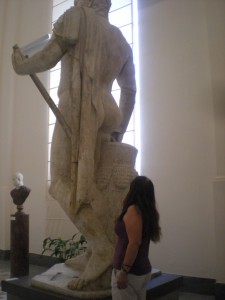
The Ant really had a deep understanding of the Farnese gallery. I think it was the fine relation of the human form that captivated her.
I, on the other hand, identified with the “labrys-bearer,†and “fish-wrangler†as I like to call them.
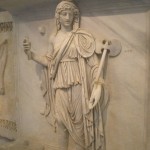
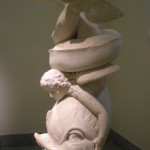
Starting to get hungry, we ran through the collection of frescoes and tools.
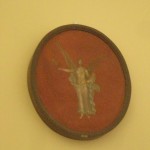
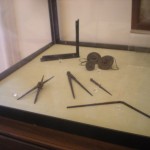
And then checked out the sundial room, which, at noon every day, shows the date with a single shaft of light thrown onto the calendar on the floor.
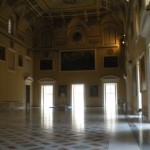
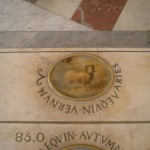
Finally, we headed into the room of Greek sculpture. From the first time I looked into the stone and bone eyes of the Greek statues in Athens, I’ve felt an affinity with these objects. A near kinship. When I look into the faces of Roman marble busts, I don’t see myself. When I look into the eyes of the Greeks, I do.
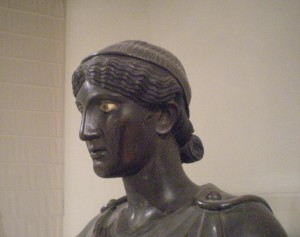
Also, their asses.
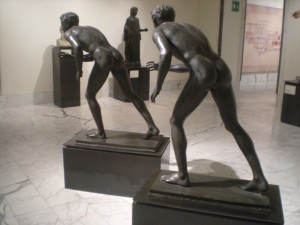
And then we saw a really fascinating modern exhibit. One with Medusa.
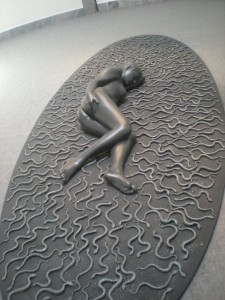
I once went for Halloween as Medusa. You know what they don’t tell you in the US? She’s Intersex.
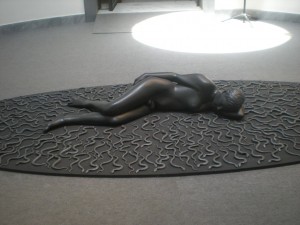
No, really. It’s part of the myth. It just gets left out. Fascinating. I might have modified my costume a bit.
After Medusa, we were able to cross the museum off our list. All that was left was pizza. Pizza. In Naples. Rick had not been super helpful thus far, but he did have the names and locations of two famous pizza places listed in his Naples section. I somehow convinced the Ant that it was necessary to eat at one of these two restaurants. And also that I’d be able to navigate us through the streets of Naples to them. Fortunately, they were across the street from each other. And so we started walking.
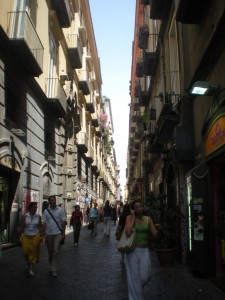
There were a lot of people. And a lot of shops. And a lot of cars and scooters, and flags waving.
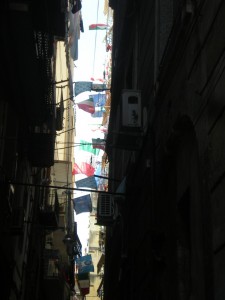
There was a lot of gum on the sidewalk. There was a lot of graffiti, too.
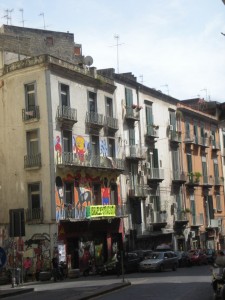
“Dirty†is the way I heard it described. In guidebooks, from other tourists, and from the people we met at lunch.
“She thinks it’s dirty.â€Â The couple next to us was visiting. She from Madrid, he from Rome.
“I like it,†I said. Not as though I was trying to be contrary. Naples really had a feel to it. Unsettled, seething – but interesting.
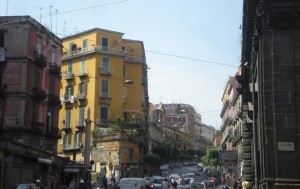
“Earthy.â€Â That’s the word I applied to the city. Maybe the word I’d apply to myself. Not sure.
“How do you eat so much.? Magra.â€
“He says you’re so skinny.â€Â The woman was translating the Italian to English. Beautiful. And he spoke to her in Spanish.
I smiled. The Ant and I had just polished off two pizzas. Two pizzas that turned out not to be ours.
In the bustle of the upstairs pizza parlor, the din that rose from the family-style tables crammed together, someone had misunderstood. When they set the two pizzas in front of us, I wondered. Then I pretended that they were two different types – our types:  margherita and 7 cheese. I even swapped with the Ant. Then we traded pieces, willing our taste buds to experience the 7 different cheeses. Yes, we were that hungry.
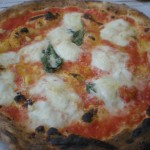
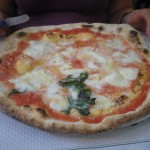
As I gobbled, I thought about the other people who might be equally hungry, waiting for pizzas that wouldn’t come. There were people inquiring about pizzas everywhere. This seemed a common issue. And then the third pizza arrived.
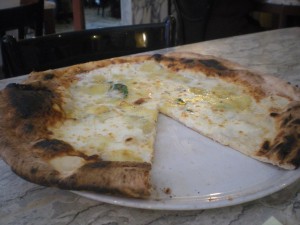
This was what a 7 cheese pizza was supposed to look like. Ahem.
The waiter looked at our neighbors who told him we’d already eaten. He shrugged and smiled and left us the pizza.
Our new friends looked at us. The people on our other side stared.
“I’ll share!â€Â I declared. They all waved their arms, distancing themselves from the fugitive pizza.
When we left the restaurant, it was with a pizza box under my arm. There was no way I was going to let that thing go to waste.
“You’re going to carry that through Naples and on the train back to Salerno?â€
“Yes, but if I find someone to give it to, I’ll do that,†I told the Ant.  She agreed.  In Portland there would be a dozen street kids asking for it the second I left. But here, I ran into nobody who was even asking for money. I found this odd in a city as earthy as Naples.
Walking back toward the museum and the metro stop, we ran into our friends Andrea and Irene from the restaurant. We chatted about the city, and exchanged contact information. Andrea told us not to show our cameras or money in the street. Then we continued on, taking in the glory of the city.
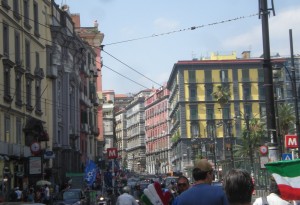
The Ant didn’t so much share my love of Naples.
The day was just getting hotter. Thinking of the crammed train ride ahead of us, we bought a bottle of water, found a park bench, and hydrated. Then I grew a little restless.
“It’s time to move,†I said to the Ant. It just felt like we’d been on that park bench a little too long.
When we stood up, a scruffy, bearded man put out his hand and asked for money.
“Una pizza buona?â€Â I asked, handing the box to him.
His face lit up. “Si. Si! Buona.â€
“Ciao,†I said and we walked along toward the station, past several big, red buildings.
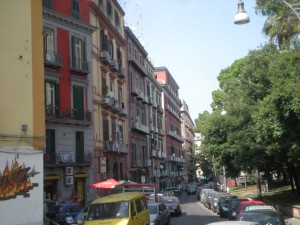
That night I had an email from our new friend.
“Kristin, you didn’t eat too much pizza?†came the Italian question.
“No, don’t worry. I gave it to a man on the street.â€
“Well, then he surely saw an angel today.â€Â I loved that he thought of a woman with pizza as an angel.
Do you see why I love Naples?  A place where graffiti artists compete for your attention with fascist architecture, and angels walk the streets doling out pizza. This is my kind of earthy. Napoli e bella.
July 1, 2010 1 Comment
Half-buried
Italy is old. It has an ancient feel about it. Yes, I know everywhere is old. I know there were native peoples in the US thousands of years ago. But, somehow, Italy feels different. Like the land has been dealing with foolish people for a very long time. You know, like the Roman Empire, and whatnot. People determined to bring about their own destruction through over-estimation of their own powers.
Now, I’m not saying that’s what happened at Pompeii. It’s not like the people there angered Mt. Vesuvius with their self-absorption. By all accounts, it was an average place, with its bakeries and villas and brothels.   Humblingly so.
The day we visited Pompei, the Ant and I got up early and caught a bus into town. Unfortunately, we missed our train by about 2 minutes. The guy at the ticket counter sold us something that looked different than the usual tickets.
“Are you sure we didn’t buy bus tickets?â€Â The Ant wasn’t at all sure about these new passes. “I think you should ask.â€
A quick question confirmed that the passes could be used for both buses and trains in the region. That was great, but the next train wasn’t for several hours. We walked across the street to our favorite tourist information office to see what our favorite tourist information officer could tell us.
“Alora, you can take the bus at 11:05.â€Â Crap. That was still 2 hours away. “Aspetta. Wait. There is one at 10:05, right out front.â€
We grinned, thanked her, and left. We had just enough time for breakfast at our favorite gelateria/coffee bar.
With pastry in our stomachs and caffeine in our veins, we ventured into a tabacchi to buy stamps. We were really feeling good about our ability to get around and get things done.
At 10:00, we boarded the correct bus, picked out the best seats (we’d ridden enough busses to know what the best seats were) and settled in. When we pulled out at 10:05 there were only about 5 of us on the bus.
Along we drove, through the countryside, and through cities. Young boys got on and off, eying our bags hungrily. The cities got grittier and grittier, with unsurprising names like “Angri.â€Â The ride went on for what seemed like an eternity. I got up to check with the driver.
“Andiamo a Pompei, si?â€Â Nothing. “A Pompei?â€Â He nodded and grumbled a bit. I returned to my seat to scour my Rick Steves section for clues.
There are times when my trusty guidebook is super-helpful, and times when I could throw it in the fire. For the most part, our trip to the south wasn’t greatly aided by the guidebook. Our day in Pompei was no exception. Rick had some decent information on how to get to Pompei from the north, but the approach form the south had nothing. His description told me that if we got off at the train station, we’d be super-close to the entrance to the ruins. I checked the name of the station, and figured that if we could get off somewhere close, we’d be good. I mean, how big could Pompei be?
So the answer to that question is that Pompei is a kind of suburb of Naples. It’s big. When the bus driver stopped and announced “Pompei,†looking back at us, I got up and took the Ant with me.
I could have asked if this was the “stazione†stop, but I didn’t. Frankly, I was tired. I was tired of thinking in a foreign language.  I was tired of formulating questions, practicing them and then bungling them with less-than-helpful bus drivers. I was tired of the shrugs and the grunts and the anxiety that comes with rejection from strangers. Not that it was always like that. Just that it was always a possibility. And I was tired.
So, we got off and started walking. There were signs for the station – in the direction that the bus had driven. We followed them for maybe 5 minutes until we came to the “Centrale†station. This wasn’t the “Scavi†station that Rick had mentioned in the guidebook. I confirmed with a cabbie who wanted to give us a ride. We were 3 Kilometers away from “Scavi†and he’d gladly take us there for 10 Euro.
Forget it. I looked at his map, and thanked him. Then we took off, walking through the streets of modern Pompei. It was still morning, and fairly cool. Even so, I think I mentioned to the Ant how much I’d always liked the phrase, “sweating freely.â€Â I’d grown accustomed to having my jeans soaked through with sweat, and my wool t-shirt damp at all times. It reminded me of Aragorn running through the hills on a great quest in the Lord of the Rings. Yeah, I’m that kind of crazy.
We walked for about 30 minutes, following signs for “Scavi†and trusting that we’d know the ruins when we saw them. According to Rick, we’d hit the ruins before the scavi station. We walked past huge churches and interesting apartment complexes.
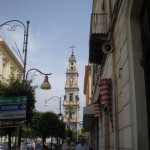
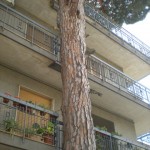
We greeted young men (I swear we saw 3 times as many men as women in Italy. I don’t know if the women are all working, or just at home with the kids, but the guys were out wandering, and drinking coffee), who all smiled at us kindly.
Lemons were everywhere. I knew lemons were an important product in the south, but in Pompei, the were seriously everywhere.  Rotting bags of them littered the street and huge, obscene fruit hung from carts.
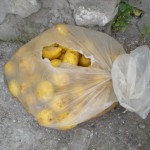
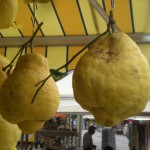
We stopped periodically for water, and I commented on how the heat really doesn’t bother me, and how important it was to make sure we stayed hydrated. “Six ounces every 15 minutes,†I sang. A familiar refrain to my softball friends.
By the time we reached what looked like a tourist area, we were both a little tired, and more than a little ready to be there. “Scavi,†read a sign, pointing up a driveway that led up a hill, and out of sight. We’d seen several of these signs along the way, often pointing in different directions. We looked at each other and sighed. It seemed like were almost there. In the back of my head I wondered what had gone wrong, and how we’d be getting home. Oh well, it always worked itself out.
Up the hill and around a corner, we found the gates to the ruins. As we approached, beautiful displays of even more lemons invited us in.
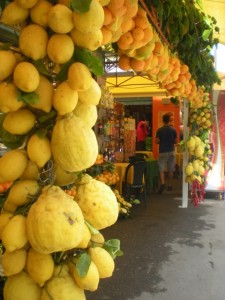
As did a “local tour guide†in his over-sized, crumpled ballcap and aviator glasses. “English? Wait 10 minutes I will organize an English tour. It will be much more affordable,†he barked at us.
“No, grazie.â€Â I wielded my familiar vendor response to little effect.
“English?!â€Â He was demanding. “Please, go this way and purchase your ticket. I will arrange a tour.â€Â The local tour guides, and even random people looking for a handout will masquerade as helpful staff members. This guy was pointing us to the ticket office. Fortunately, Rick had warned us about this, so we were prepared. Others seemed baffled.
Once we had our tickets and free map (thanks to Rick’s excellent information about where to get one), we hit the WC. The entire time, we listened to the barker trying to organize the tour. “Next tour English with local guide. Next tour in English! Please, purchase your tickets! This way…â€
Feeling just a little superior in our knowledge, we emerged, skirted the guide and headed to an overlook area.
The last time I was in Italy, it was the off season. O-F-F. There aren’t a lot of tourists visiting Rome and Venice in November and December. I’d like to keep it that way. Standing at the Pompei overlook, I flashed back to a CS Lewis novel I’d read as a kid. “The Silver Planet†was this great sci-fi story about, as I remember it, a man who goes into space for an extended period of time, living on another planet. The part that came back to me now was a scene when, after a long time away from home, he watched unfamiliar creatures come over the horizon, hairy and gruff in their manner, speaking a harsh, unbeautiful language. It took him a moment to realize they were humans speaking English.
All around me, the beautiful melody of the Italian language disappeared into a sea of shouted names, pushing, scrambling as though the ruins would somehow be used up, fear and scarcity the dominant energy.
“Let’s get inside, shall we?â€Â I could hardly bring myself to look at the Ant. I just wanted to disappear.
Once out of the crowd, I took a moment to look around. Pompei is amazing. It really is “You’re going to be amazed, girl.â€Â I’d been told by my buddies that this would be an amazing experience. But it’s hard to prepare for something like Pompei. In fact, I’m not sure there’s a lot I can say about it.
We walked through the forum, along the streets. We noted the stepping stones that allowed chariots through and provided a path for pedestrians when the streets were flooded for cleaning every night.
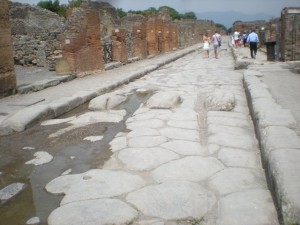
We looked into the distance at the crater of Vesuvius, and imagined the plume of ash that had risen from it. And fallen where we were standing, killing and preserving everything. Leaving the record we were now snapping pictures of.
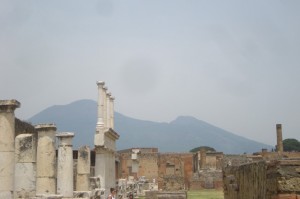
We saw bold-colored frescoes and strong mosaics.
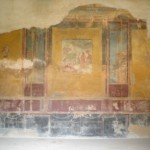
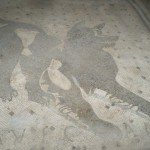
Shrines and fast-food joints.
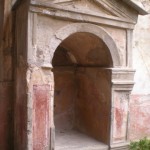
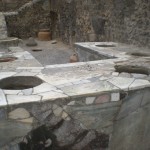
Huge pots, half-buried, and intact dotted the rooms.
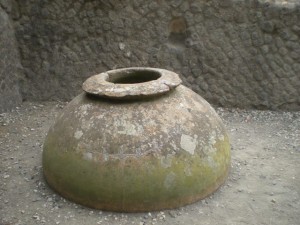
And tourists crowded along the fence that protected the remaining artifacts. The tools, and art left behind. And the people. The plaster casts made from the spaces left when the bodies of Pompeians had decomposed.
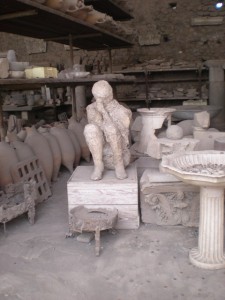
I took a picture of one of the most famous and left the rest to be mobbed.
My favorite part of the site was the public baths. From the beautiful outdoor gymnasium,
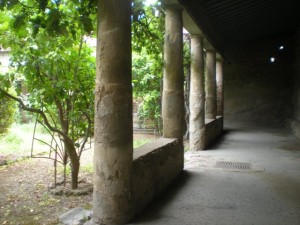
To the immense steam fountain inlaid with the names of the politicians who paid for it.
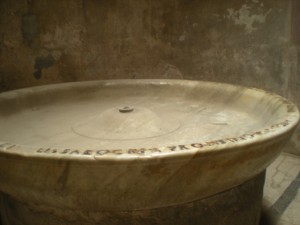
The baths provided an intimate look into the life I would have been most drawn to in Pompei. At once physical, artistic, and engineered, they intrigued me with their temperature-controlled double walls and bronze heater. They were so well preserved that they reminded me of images of the gym on the Titanic.
This place really was amazing. We wandered around, taking in the 2,000 year old lead pipes, and the water-towers. The double-boilers that kept food warm. Then we took in the snack shop. And the Powerade. Pompei was cool, but it was also hot. Really, really hot.
And I swear it had ears. Just like Venice it heard me bragging. And it landed me on my ass. Even after drinking several bottles of water and a Poweraid, the ground was shifting under me. My statement about not being affected by the heat caught in my throat.
“So, what do you think about heading back?â€Â I wasn’t usually one for leaving anything unseen, but I wasn’t used to having my body betray me, either.
The Ant looked at me. “I wouldn’t be upset if we headed back.â€
“Okay, then I think it’s time. My body is rebelling.â€Â Along with the baths, I’d really wanted to see the brothel, and its frescoes that served as a kind of menu of services. But at that point, even the dirty frescoes were forgotten.  All I was thinking about was finding the “Scavi†train station that Rick Steves had promised was so very close to the ruins.
I consulted the Pompei section of Rick’s book that I’d torn out and put in my pocket. I reversed the directions from the station to the ruins, and determined that we needed to go right. After walking for about 10 minutes, it was clear that something was wrong.
“Maybe we should go in and ask,†suggested the Ant, pointing to a tobacco shop.
“Maybe.â€Â I was still having an attitude crisis about having to ask directions in Italian. Still, I walked in to the tiny shop and waited behind a couple of local guys to talk with the shopkeep, who was sitting on a stool behind what looked like bullet-proof glass.
“Prego. Dove il stazione?â€
All three guys answered. Waving their arms, they pointed us back out and to the right. On the way we’d been heading.
“Grazie, ciao!â€
I walked back out to the Ant. “Yeah, they said to go up here.â€Â  Neither of us was too excited to keep on, in the opposite direction from the “Centrale†station we’d been at earlier in the day. But, on we walked, wondering when we’d see the station.
There were scarce few people on the sidewalk, giving us little opportunity to confirm that we were, indeed, headed in the right direction. So when we saw a man getting into a car just ahead of us, the Ant lunged forward, suddenly inspired.
“Staztione?â€Â she ventured.
He responded in rapid Italian.
“No parlo bene. Mi dispiace,â€Â I interjected. We weren’t in any space to work this out in Italian.
“English?â€
“Yes. Where is the train station?â€
He pointed back the way we’d come. “Three kilometers.â€Â Damn.
“Stazione Scavi?â€Â Rick said there was a Scavi station close to the ruins.
“Where are you going?†he asked.
“Salerno.â€
“No, Stazione Centrale. There is a Circumvesuvia station here, but it does not go to Salerno.â€
Shit. That’s the line Rick had talked about. I hadn’t considered that it wouldn’t go to Salerno.
“Okay. We know Centrale. Grazie. Ciao.â€Â Well, at least we knew where we were going. It was just another 20 minutes we’d added by walking this way in search the Scavi station. We pulled out our water bottles to hydrate. Our guide got in his car and began to drive off. I was a little disappointed. After our excellent experiences in Potenza I’d really rather expected that he’d offer us a ride.
Then he pulled up to us and got out of the car.
“There is another station closer. Torre Annunziata Centrale.â€
“Come?â€Â I caught a couple of the words, but this was a crazy name.
“Torre Annunziata Centrale.â€Â He pointed back the way we’d been heading.
“Okay, how far?â€Â The idea of another wild goose chase wasn’t interesting to me.
“Maybe 15 minutes if you walk. But 2 minutes if I drive you.â€Â He opened the back door.
“Grazie.â€
We climbed hungrily into the air conditioned interior of his black sedan. I nearly told him he was an angel, but thought I’d hold back to see if he slaughtered us, first.
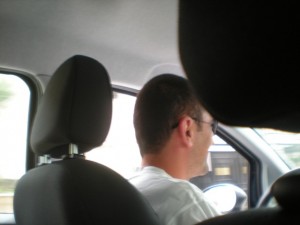
“Is this your first time to Pompei?â€
“Yes. Are you from here?â€
“Yes. Well, from Naples. It’s all the same.â€Â Oh really. That explains how we could be walking for an hour in one direction and not reach the end of the town.
“Thank you for the ride. Molto gentile. What is your name?â€
“My name?â€Â He seemed amused. “Angelo.â€Â Of course it was. Of frickin course.
“Grazie mille Angelo.â€
“Niente.â€Â How could he say it was nothing. It meant so very much to us, strangers who were so very tired.
He dropped us at a little train station and we headed inside, waving goodbye. I looked up and noticed a street sign. A brown one that had a picture of ruins on it. And said “Scavi.â€Â No way. And it dawned on me. Scavi meant ruins. Yes, there might be a “Scavi†station, but all the signs we’d been seeing pointing in different directions weren’t signs to the station. They were signs to the ruins. Cazzo. I almost laughed at myself. Almost. But I was too tired.
We checked the departure board. The next train was leaving in 20 minutes. Just enough time to pee and find the right platform. And to learn the name of the station.
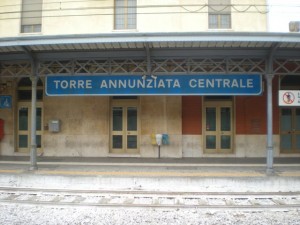
No way. I didn’t need to know the name of the train station.
July 1, 2010 1 Comment
Not-so-free beach
I spent a couple of afternoons on free beaches in Salerno. Carmine had pointed to a few of them on our first day orientation drive around the city.
“How are the free beaches?â€Â I’d asked. The idea of paying to sit in the sand is a foreign concept to someone from Oregon. The beaches in the state are all considered public. All of them. Every grain of sand.
In Salerno, however, probably 80% of the sand is contained within fences and barriers, cordoned off into color-coded parcels marked by striped umbrellas.
Early into the trip I’d decided to take a run over to one of the free beaches that was halfway between our apartment and downtown Salerno. It was about a 20 minute run, perfect on a hot day. I packed up my towel, water bottle and book. I left anything valuable, including my camera and ID home.
When I returned with my aunt, a week or so later, however, I made sure I had my camera. The scene was just too rich to miss. I’d risk it.
The walk to the strip of beaches took us through the underground passage for the under-construction train station, along stretches of abandoned private beach resorts, and past an ancient lighthouse.
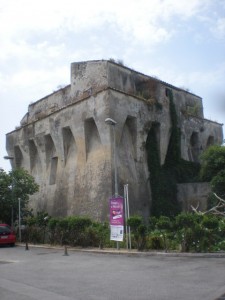
The day was really quite hot, and the humidity was pushing us into the realm of uncomfortable. We laughed as we walked past a disembodied room fan on the sidewalk.
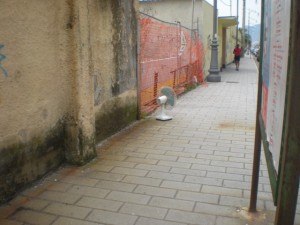
The Ant was a trooper throughout the trip. Whether walking too far along the beach, or dragging a suitcase over the bridges of Venice, she only occasionally asked me if we were there yet. Today, though, I could sense that she was wondering whether I had sent her on a death march.
“We’re almost there,†I said, pointing at the cabanas we were passing on our left. “We just have to go past these ones with red roofs, then some blue ones, and then the other red ones.â€
Almost there. What it really meant was that I knew where we were and where we were going. Not that we were, actually, close. The Ant knew this.
“Okay,†she nodded. I knew she wasn’t convinced.
Forty-five minutes, and several water-stops later, we were there, at the free beach, staking out our spots, and taking in the scene.
Free beaches are free for a number of reasons:
- Nobody cleans up the trash that is washed up or left behind.
- There is no shade.
- There is no fresh water, either for drinking or washing.
- Beach vendors are allowed to walk along, and peddle their wares to anyone and everyone, relentlessly.
The vendors are easily enough dealt with. A simple, “No, grazie†said firmly, and often, even over the top of the low-toned pitch, will almost always work. It’s just that the process has to be repeated every 2-7 minutes as a new vendor, always a young man, and almost always a dark-skinned African immigrant, wanders by, tries to catch your eye, moves in close, and presents his product. Sometimes it’s beach toys. Other times clothing, or bolts of fabric. Once in a while it’s jewelry or small pieces of art.
They start in Italian, then move to English, or German, or whatever language they determine will garner the most response. With each firm, “No, grazie†I lament my inability to connect on a human level. Eye-contact always prolongs the interaction, serving as a kind of affirmative response to their wares.
In the US, I will usually take the time to look a street vendor in the eye before saying, “no thanks.â€Â But here, in a less-familiar place, I feel unable to do so. And saddened by that reality. I also feel humbled. As I listen to these men, watch them comb the beaches for the few Euro they will make each hour, I am incredibly humbled by my ignorance. And my privilege. That’s not a word I use lightly, but it feels apt here. I speak one language. I know a few words of Spanish and a few of Italian. Not enough to get by selling garments on a beach. My fear of misspeaking gets in my way. Yet these beautiful vendors speak unabashedly with me, passing through their rotating vocabulary, hoping to hit on a language familiar to me. And here I sit, with the great good fortune to say, “no, grazie.â€
Today, though, the vendors were light, leaving us room to take in the vignettes unfolding before us.
What I had found most interesting on my first trip to the beach was the gender dynamic that was so heady. The boys were in one area, and the girls in another. There was one girl that ventured into the area up against the paid beach wall where the boys had claimed the shade. She had a bemused look on her face the entire time. Crouching inside the protection of her towel, as though she wasn’t sure how she’d managed to put herself there, and not entirely sure it was a good idea.
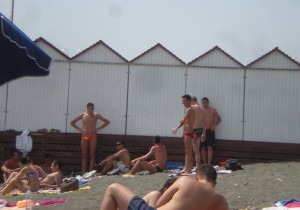
The rest of the girls were traveling in packs, venturing into the water, and out again, inching closer to the boys that were playing soccer in the foamy sand. Interactions between the genders were punctuated by raucous clashes: sand kicked at a girl, and the resulting screech.
More interesting, though, was the interaction between the boys.
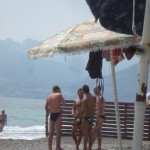
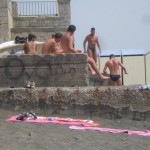
It has taken me a while to become comfortable with the overt sexuality that is part of Italian culture. It seems strange to some people, that the country that is home to the Vatican is so sexually charged. Yeah, it’s a little weird, but it’s there. And on the beaches, the sexual electricity that lies just below the surface was almost alarming to a kid who grew up in a country like the US.
Laying on my little towel, I peeked from under my hat and over my sunglasses to watch.
The four boys in front of me looked like they were maybe 19, maybe 20. Old enough to have the bodies of men, but still awkward in their bravado, adjusting their tiny bathing suits, and opting to let the sun reflect off of their wet bodies, rather than towel off.
They would take turns hoisting their well-tanned bodies from the sand and diving into the sea to cool off. They would emerge, and with a well practiced move, brush the water from their hair to good effect, leaving it spiky, erect, interesting. Then they would lie down next to each other to let the sun dry them.
The girls would scamper around the sand, pretending not to notice, adjusting their equally tiny suits and making sure the ball they were kicking around would drift into the boys’ line of sight every so often.
For their part, the boys seemed honestly disinterested in the girls. They took more interest in each other, leaning on each other’s shoulders, laughing together. At least most of them. Twice I watched as two older-looking guys came over and asserted their dominance – physically and directly.
First was someone who seemed to be a friend. His towel was positioned with the other 3 in front of me. In his racy red suit and shaved head, he was more muscular than the others. Throwing all of that muscle on top of one of the smaller boys, he crushed his body into the other, almost the way a wrestler would dominate an opponent.
Hips ground into the other, arms pinning the smaller boy’s arms above his head, the bigger boy laughed into his ear as the others watched. Then, when he’d decided the emasculation was enough, he rolled over onto his own towel, and all returned to normal. Except for me. I was a little scarred.
About a half hour later, as I was just getting over the first exchange, a much older and bigger boy with a tattooed leg, and longer shorts made his appearance on the beach. He was apparently known to many on the beach. “Nicola!†came the cries from different areas. It wasn’t clear to me whether he was loved or feared. Only that he was known. He made a wide circuit, strutting from group to group, his soft body a contrast to the younger, more athletic boys. His tattoo a brazen one, taking up the entirety of his left calf.
After spending time with the group along the wall, and kicking the soccer ball out of the group at the water’s edge and into the ocean, he came over to my boys. Only one of them was on his stomach. Nicola headed straight for him, and dropping his body down, placed one knee roughly in the other boy’s lower back, apparently trying to separate his hips from the rest of his body.
The boy screamed, actually screamed as Nicola pinned his arms to his side and laughed. The others looked nervously over, but they only watched as their comrade struggled fruitlessly to move out of the hold, crying out, “Nicola, basta!â€Â When he decided it was enough, Nicola released his hands, and pushed off of the boy, up to a standing position, still laughing.
The boy did nothing. He lay there, and adjusted his suit. Nicola greeted the others. It wasn’t a friendly greeting he received. Just a nod and maybe an embraced hand. Not like the hugs and heads leaned onto each other’s shoulders. This boy, this bully was both enforcer and violator. His presence was accepted, expected, but not appreciated.
Nicola walked away. He had no towel. He had no group. He had no girls looking slyly at him, or boys welcoming him. I didn’t see where he went as I gathered my towel and book and headed out.
On the way home from our beach excursion, the Ant and I stopped for an emergency gelato. Along the dingy street that led to the underpass, we ducked into a nondescript bar with a dark-browed man behind the counter. He peered at us, clear strangers in this locals’ bar.
We smiled our hellos, and moved toward the unpromising gelato case. The flavors were meager, and clearly not house made. But we were in a bad way, so it would have to do.
As soon as he saw us move toward the case, he melted. Whether we reminded him of family members, or he just liked gelato, too, he patiently waded through our butchered Italian, and soon enough we had lovely cones of respite. We sat in the cool shop and ate quietly, the World Cup showing in the background.
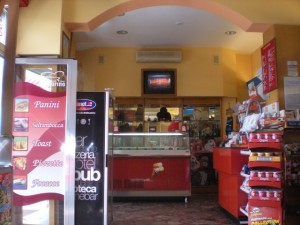
When we stood to leave, the shop-owner called to us in a friendly tone, and we waived, the familiar, “Ciao! Grazie!†tossed back and forth.
In the now-short blocks home, we walked, looking down the alleys that led from the ramshackle street to the beach. I pulled out my camera to capture a boat I’d noticed before. And, as I raised the camera, something caught my eye.
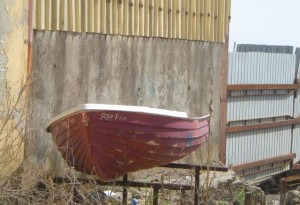
“Redfish.â€Â The white name scrawled along the dusty red hull of the rowboat rang out to me, the name of the lake and the beach where I’d spent my childhood summer weekends. The place where I’d played with the boys and watched the girls. The little boat smiled back at me, playful and comforting.
June 30, 2010 1 Comment
Unexpected beauty
Our trip to Salerno was a scouting mission. An attempt to find interesting towns where the Ant could retire. We spent our time taking day trips around the region, with days off in Salerno. The days off were mostly days of rest, the two of us lounging around the apartment, or heading to the café down the street. Food was always a part of the equation, whether pizza from our favorite place, or fried balls of stuff from a cart.
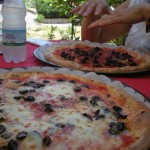
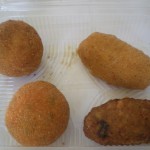
On one of our days off we decided to explore Salerno’s history. We knew three things about ancient Salerno. First, it had an important duomo. Second, it had a big castle. Third, it had some medicinal gardens. We were most interested in seeing the castello, which overlooked the city from a big hill, so we took the bus into town and started walking up.
Our map, which wasn’t topographical and only showed us streets, indicated that it would be feasible to walk to the castle. We picked out the right road and wound our way through the streets of medieval Salerno. We happened upon the duomo, which seemed much more interesting in the guidebooks than in real life.
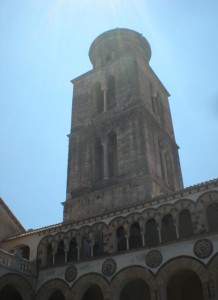
The dreariness of Salerno was only slightly less here.
Up, up, up we wound, the streets getting narrower as we walked. Somewhere along the way we began to wonder if we were still on the right road. So I ducked my head into some kind of a historical center, and found a beautiful young woman who seemed to be waiting to help us.
“Mi dispiaci, no parlo bene, l’italiano.â€Â I smiled my usual greeting, noting her abrupt movements as she came over to us.
“English?â€Â Like so many others, she’d guessed right.
I handed her our little map and asked where we were.
“Oh, mmm, allora, mmm.â€Â She muttered as she looked at the paper, turning it around on the counter we were leaning over. She located our position on the map, after a good bit of studying.
“What are you looking for? Il giardino della Minerva?â€
“The Castello,†the Ant and I answered together.
The woman looked at us. “No, no, no. It’s too far. It’s not possible.â€
The Ant and I exchanged dubious looks. We wanted to see the castle, but we weren’t especially up for an impossible climb.
“But the gardens are very close. Very beautiful.â€
The Ant was nodding fervently. “Okay.â€
Our guide folded up the map and handed it to me as she led us to the door.   “Walk up here, and keep going, always forward.â€Â Good advice. She returned the amused smile I flashed her. We thanked her and headed up the hill in the direction she had pointed.
The Ant turned to me with a wry look on her face. “Well you certainly do know how to find them.” A little embarrassed, I chuckled and looked at the cobblestones we were walking. Yes, it seemed I did know how to walk into a shop and find a helpful, pretty girl.
And she was right, it wasn’t far, but it’s not likely we would have found it without her instruction. The undulating streets of this part of Salerno were a bit maze-like, due (as we would find out) to the fact that it was built on the side of a cliff.
Inside the unassuming gates of the garden, we paid our euros, grabbed the 4 page, single-spaced, English-language info pamphlet on the gardens and started mulling about. The pamphlet told us that these gardens are recognized as the first medicinal gardens – ever.  The sense of peace and calm inside the gates was beautiful. We spent the next hour or so wandering through the three levels of the gardens, snapping pictures, taking video, smelling plants, trying to identify some of them. Plants strange to that part of the world, like Taro, materialized in the boggy beds around fountains. Fish swam in pools with lily-pads. I’m not sure if we saw any other visitors to the gardens. It was like our own, private playground.
The gardens are built on the site of natural springs, so the entire location is filled with channels bringing water to the myriad of beds and fountains.
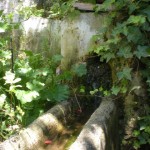
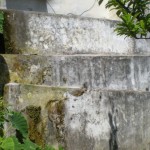
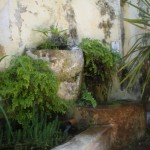
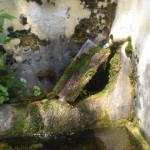
The terraces were connected by a staircase that was built as part of the outer wall, on the side of the cliff. It treated us to spectacular views.
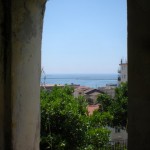
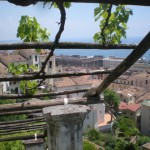
As we reached the top level, the woman from the admissions office came up behind us to tell us they were closing for lunch.
I grabbed a couple of last pictures and we made the climb back down to the gate.
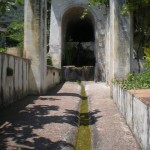
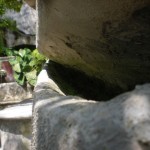
We hiked back out toward the duomo, winding back through the streets where people live among a remarkable history.
We hadn’t eaten in something like 2 hours, so we were starving and stopped for a calzone at the first place we came to. The Ant had something meaty, and I had something that equated to a salad in a calzone.

Much like the gardens, and the woman who led us there, it was quite unexpectedly lovely.
June 28, 2010 2 Comments

